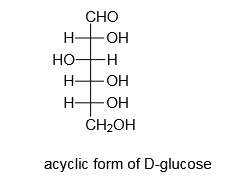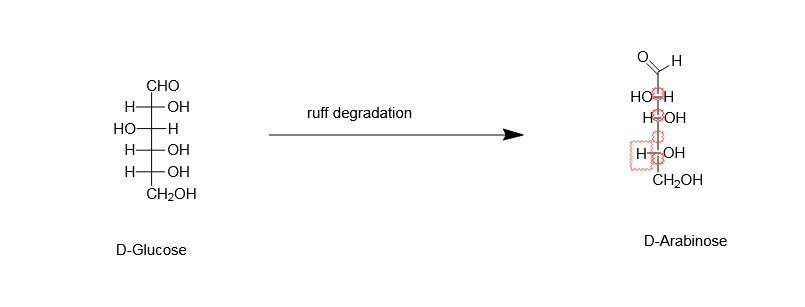Answer
40.2k+ views
Hint: Ruff degradation is a synthetic method to shorten the carbon-chain. It was first studied by Otto Ruff on glucose molecules.
Complete solution:
If we will add an aldehydic group to an acyclic form of monosaccharide, the resulting monosaccharide will be an aldose.

Ruff degradation will shorten the above chain by removing one carbon atom.

The overall conversion mechanism can be stated as follows-
The terminal aldehydic group is made to undergo selective oxidation, by using bromine water, and then it is converted to gluconate ion. In the next step, $Fe(OAc)3$ with 30% of $H2O2$ is added. This will result in the formation of $CO2$ along with a stereo selective compound from COO- ion. And in the downside, $ - CH2OH$will get converted to $ - CHO$ group. This conversion is achieved by the reduction of iron $Fe$ from its +3 state to +2 state. In this way, we get the product, D-Arabinose.

So, the correct option is D.
Note:
Ruff degradation has been named after its discoverer, Otto Ruff.
Alcohol dehydrogenase (ADH) is the enzyme that can break down alcohol into acetaldehyde. This enzyme can be found in the liver cells.
Arabinose acts as an inhibitor of enzyme Sucrase. This enzyme is present in the small intestine and helps to break down sucrose into fructose and glucose. Because of this ability, it is commercialized as a sweetener.
Arabinose is also used as a reversible switch for protein expression in E.coli
Complete solution:
If we will add an aldehydic group to an acyclic form of monosaccharide, the resulting monosaccharide will be an aldose.

Ruff degradation will shorten the above chain by removing one carbon atom.

The overall conversion mechanism can be stated as follows-
The terminal aldehydic group is made to undergo selective oxidation, by using bromine water, and then it is converted to gluconate ion. In the next step, $Fe(OAc)3$ with 30% of $H2O2$ is added. This will result in the formation of $CO2$ along with a stereo selective compound from COO- ion. And in the downside, $ - CH2OH$will get converted to $ - CHO$ group. This conversion is achieved by the reduction of iron $Fe$ from its +3 state to +2 state. In this way, we get the product, D-Arabinose.

So, the correct option is D.
Note:
Ruff degradation has been named after its discoverer, Otto Ruff.
Alcohol dehydrogenase (ADH) is the enzyme that can break down alcohol into acetaldehyde. This enzyme can be found in the liver cells.
Arabinose acts as an inhibitor of enzyme Sucrase. This enzyme is present in the small intestine and helps to break down sucrose into fructose and glucose. Because of this ability, it is commercialized as a sweetener.
Arabinose is also used as a reversible switch for protein expression in E.coli
Recently Updated Pages
silver wire has diameter 04mm and resistivity 16 times class 12 physics JEE_Main

A parallel plate capacitor has a capacitance C When class 12 physics JEE_Main

Let gx 1 + x x and fx left beginarray20c 1x 0 0x 0 class 12 maths JEE_Main

A series combination of n1 capacitors each of value class 12 physics JEE_Main

When propyne is treated with aqueous H2SO4 in presence class 12 chemistry JEE_Main

Which of the following is not true in the case of motion class 12 physics JEE_Main

Other Pages
If a wire of resistance R is stretched to double of class 12 physics JEE_Main

How many grams of concentrated nitric acid solution class 11 chemistry JEE_Main

A closed organ pipe and an open organ pipe are tuned class 11 physics JEE_Main

Formula for number of images formed by two plane mirrors class 12 physics JEE_Main

In order to convert Aniline into chlorobenzene the class 12 chemistry JEE_Main

Which of the following is not a redox reaction A CaCO3 class 11 chemistry JEE_Main



